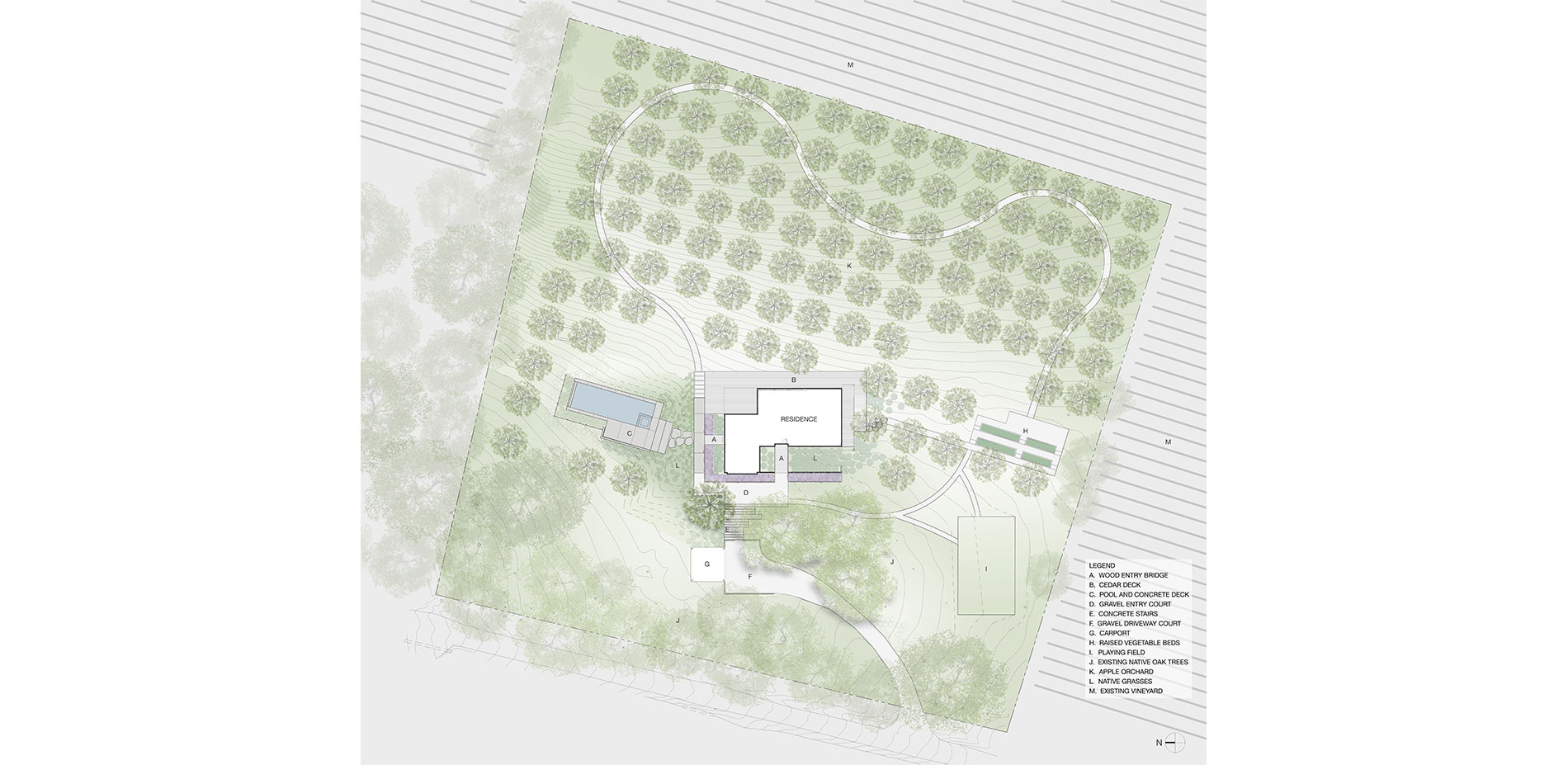Where Agriculture Meets Coastal Woodlands
Honor Award
Residential Design
Sebastopol, CA, USA
Longwell MacDonald
"Located in an old apple orchard, the landscape created for this second home in a Northern California farming community is deliberately restrained, allowing the site’s spectacular views to predominate, and not interfering with the live oaks that have reclaimed portions of the orchard. The various elements of the design adopt materials commonly found on farms in the area, including the concrete walkways and platforms, gravel paths to a vegetable garden, board-formed concrete steps at the entrance, and wood steps to a revitalized fruit orchard on the lower section of the site. The scarce water supply is carefully conserved, making this project as environmentally viable as it is beautiful."
- 2019 Awards Jury
Project Credits
- Longwell MacDonald, Landscape Architect
- Jan Longwell, ASLA, Lead Designer
- Laura Goard, Assistant Designer
- Cary Bernstein Architect, Architect
- Tomrose Construction, General Contractor
- Siteworks Landscape, Landscape Contractor
- Stan Johnson Pool Construction, Swimming Pool Contractor
Project Statement
The three-acre site is at the intersection of coastal oak woodlands and cultivated fields of vineyards and Gravenstein apple orchards. The Gravenstein was the most widely grown crop in the small farming community of Sebastopol in Northern California during the early 20th century when much of the harvest was used for apple sauce and dried apples shipped to troops during WWII. Due to disease and lower yields, only a few orchards remain that have not been replaced by the more profitable grape growing. The house and an existing neglected Gravenstein apple orchard share the property with coastal live oaks that have gradually reclaimed the hedgerows and sections of the orchard that died. Where the apple trees have succumbed to the oaks, the design allows the oaks to reclaim their natural habitat. In areas where the fruit trees are still healthy, the agricultural history of apple cultivation is preserved by restoring portions of the orchard with new trees.
Project Narrative
The Client and Community
The site is in a rural setting where the client engages in farm living, grows and cares for vegetable gardens, fruit trees, and enjoys the outdoors. The property is a refuge from the city for the client, as well as a welcoming retreat-like place for friends and families to come and stay for extended periods of time. During the Northern California wildfires, the house was used as a temporary shelter for several families who lost their homes.
The Site and Materials
The open landscape and spectacular views dictate a design that intervenes with subtlety. The introduction of simple forms and the use of vernacular materials are used as means to appreciate the natural beauty and history of the site. Upon entering the property, the concrete steps, board formed concrete, gravel courtyards, and a wood bench recall the utilitarian materials that are typical in the farming community. The orthogonal concrete platforms focus the attention on the vineyards in the distance while highlighting the delicate textures and patterns of lights and shadows of the native grasses. The “arms” that extend from either side of the house to the pool decking and gravel walk to the vegetable gardens define the region where the farmed and gridded patterns of the vineyards and orchard meet the less controlled landscape consisting of live oaks and California fescue. A wood bridge spans a stretch of deer grass before entering the house at the front and side yards. The concrete walk engages the distant landscape and connects the entry courtyard to the rear deck and terminates with wood steps to the orchard below.
The Land
Because of a scarcity of water in California, the terrain is graded to utilize roof run-off and rainwater as sources of irrigation for the more water demanding apple orchard. Water is directed through a shallow swale between the pool and the house, terminating in a deep gravel trench that holds water during heavy rains and slowly releases it to the apple orchard at the lower property. Due to disease, neglect, and age, half of the existing Gravenstein apple orchard was replaced with ‘Red Fuji’ and ‘Pink Lady’ apple varieties grafted to a drought and high temperature resistant rootstock. Ideal for storing and shipping, the hearty apples are important given that a portion of the harvest is donated to local food banks and shelters where they are easily stored for a length of time.
In the oak woodlands, a competing understory growth of exotic shrubs and trees prevented the oaks from reaching full maturity. The undergrowth was removed and replaced with native California fescue and deer grass. The portions of the site that were disturbed during construction were planted with a native grass and wildflower seed mix to reduce the number of invasive non-native grasses and perennials that covered the site before construction. A cover crop of crimson clover was planted between the fruit trees in the orchard. After the carpet of red flowers bloom, the legume is tilled into the ground which provides nitrogen to the soil, protects the soil from erosion, and competes with weeds.
Products
Product Sources: SOILS
- Soils and Amendments: Wheeler Zamaroni
Product Sources: HARDSCAPE
- Concrete Color: Scofield
Product Sources: LIGHTING
- Path Lights: B-K Lighting
- Recessed Lights: B-K Lighting
- Up Lights: B-K Lighting
Product Sources: IRRIGATION
- Irrigation: Urban Farmer
Plant List:
- Bare Root Apple Trees: Dave Wilson Nursery
- Native Grass Seed: Harmony Farm Supply and Nursery
- Native Wildflower Seed: Harmony Farm Supply and Nursery

.jpg)
.jpg)
.jpg)
.jpg)
.jpg)
.jpg)
.jpg)
.jpg)
.jpg)
.jpg)
.jpg)
